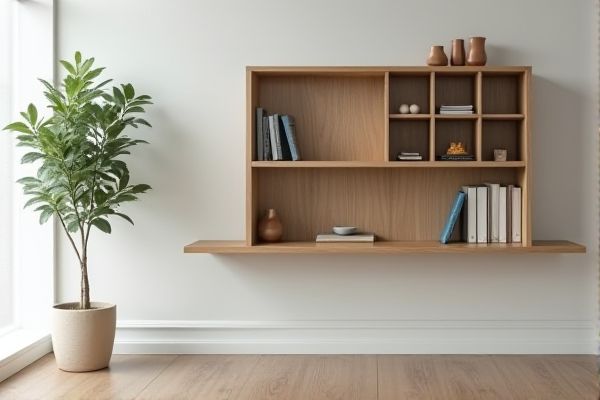
Ledge shelves offer a sleek, minimalistic design perfect for displaying books or decor with easy access, while cubby shelves provide segmented storage ideal for organizing various items in distinct compartments. Discover which option suits your space and style best by reading the rest of the article.
Table of Comparison
| Feature | Ledge Shelf | Cubby Shelf |
|---|---|---|
| Design | Flat surface with a raised edge for holding items | Compartmentalized storage with box-like sections |
| Best Use | Display books, frames, and small decor | Organize books, toys, and bulkier items |
| Space Efficiency | Compact and minimal footprint | Provides more storage but occupies more space |
| Accessibility | Items easily accessible and visible | Items stored in separate cubbies; some items less visible |
| Installation | Wall-mounted; simple setup | Freestanding or wall-mounted; more complex setup |
| Material | Commonly wood or MDF with minimal thickness | Usually thicker wood, metal, or plastic for durability |
| Weight Capacity | Supports lighter items | Supports heavier and bulkier items |
Introduction to Ledge Shelf vs Cubby Shelf
Ledge shelves offer a sleek, minimalist design perfect for displaying books, photos, and small decor with easy access and visibility. Cubby shelves provide a more structured storage solution, featuring multiple compartments to organize various items neatly and keep your space clutter-free. Choosing between a ledge shelf and a cubby shelf depends on whether you prioritize open display or compartmentalized organization for your room.
Design and Aesthetic Differences
Ledge shelves feature a minimalist design with a flat surface and a raised edge, ideal for displaying pictures or small decorative items securely, emphasizing simplicity and modern aesthetics. Cubby shelves consist of multiple enclosed compartments, offering a more structured and versatile storage solution suited for organizing books, toys, or collectibles while enhancing room decor with a sense of order and functionality. Your choice depends on whether you prefer a sleek, open display or a segmented, compartmentalized approach to storage and design.
Space Efficiency Comparison
A ledge shelf maximizes vertical space by allowing you to display items without depth constraints, making it ideal for narrow walls and small rooms. Cubby shelves offer compartmentalized storage, efficiently organizing multiple items but requiring more floor or wall space due to their bulkier design. Your choice depends on whether you prioritize minimal footprint and easy access (ledge shelf) or segmented storage for categorizing items (cubby shelf).
Storage Capacity: Ledge vs Cubby
Ledge shelves offer limited storage capacity ideal for displaying small items such as picture frames or decorative pieces, while cubby shelves provide more substantial storage with individual compartments perfect for organizing books, toys, or office supplies. Cubby shelves maximize space efficiency by allowing you to separate and store items neatly, enhancing both functionality and accessibility. Choosing between ledge and cubby shelves depends on your storage needs and the type of items you want to organize in your space.
Ideal Uses for Ledge Shelves
Ledge shelves are ideal for displaying small decor items, picture frames, or books, providing easy access and changing layouts without heavy installation. Their slim profile makes them perfect for narrow walls or spaces where you want to add function without bulk. You can enhance your room's visual appeal while keeping essentials within reach by choosing ledge shelves over bulky cubby shelves.
Best Applications for Cubby Shelves
Cubby shelves excel in organizing small items like toys, shoes, or office supplies, making them ideal for classrooms, playrooms, and entryways. Their compartments provide clear separation and easy access, enhancing tidiness and visual order. This functionality is perfect for spaces requiring segmented storage solutions and quick item retrieval.
Installation and Maintenance Requirements
Ledge shelves require simple wall mounting with brackets or hooks, making installation quick and suitable for various wall types, while cubby shelves often demand more complex assembly and secure anchoring due to their bulkier design. Maintenance for ledge shelves is minimal, involving occasional dusting and cleaning, whereas cubby shelves may require more effort to clean inside the compartments and maintain structural integrity over time. Choosing between the two depends on the ease of installation and the level of upkeep one is prepared to manage.
Material and Durability Considerations
Ledge shelves are typically made from solid wood or MDF with a protective finish, offering sturdy support for items like picture frames and small decor, ensuring durability over time. Cubby shelves often utilize materials such as laminated particleboard or plywood, designed for lightweight storage but may be more susceptible to wear and moisture damage. Your choice should consider the material's strength and finish to match the intended use and environment for long-lasting functionality.
Cost Differences: Ledge Shelf vs Cubby Shelf
Ledge shelves generally cost less than cubby shelves due to their simpler design and fewer materials needed for construction. Cubby shelves, featuring multiple compartments for organized storage, often require more wood and labor, increasing the overall price. When choosing between the two, consider your budget alongside your storage needs to determine which shelf fits your space and financial plan best.
Choosing the Right Shelf for Your Space
Ledge shelves offer a minimalist design perfect for displaying art, photos, and small decorative items without taking up floor space, ideal for narrow walls or tight corners. Cubby shelves provide versatile storage with multiple compartments, making them suitable for organizing books, toys, or office supplies in larger rooms or play areas. Selecting between ledge and cubby shelves depends on the desired balance between display aesthetics and storage functionality tailored to your room's dimensions and usage.
 homyna.com
homyna.com